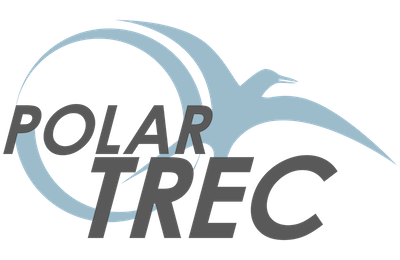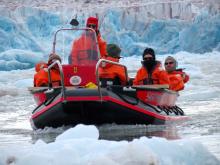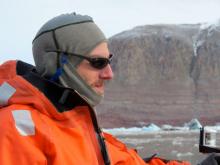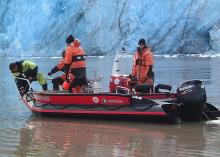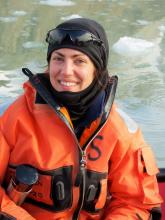Update
You can access PolarConnect webinar live events, including the event held by Peggy McNeal, here in the PolarConnect Archives
What Are They Doing?

The research team, which includes undergraduate geoscience students participating in the Research Experiences Undergraduates (REU) Program, traveled to Svalbard to research how high latitude glaciers, melt-water streams, and sedimentation in the fjords reflect climate. The Svalbard region is ideal for the study of past climate because several different types of measurements on and around glaciers can be conducted there. Working out of small boats in the fiord and hiking to sites on land, the team collected data to determine what relationships exist between current sedimentation, glaciers, oceans, and climate. Using the historic sedimentation record can help the researchers understand and better predict how glacial systems react to climate change.
Where Are They?
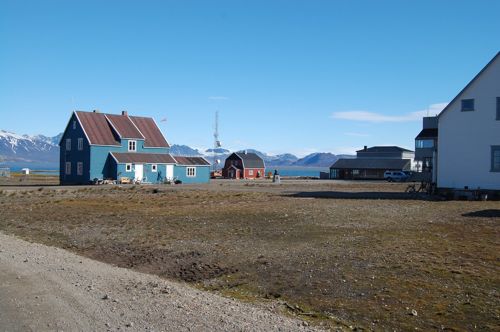
Latest Journals

Ross Powell has been a professor in the Department of Geology and Environmental Sciences at Northern Illinois University since the early 1980's. His main research interests focus on processes where glaciers and ice sheets enter the sea, and his recent research has focused on Alaskan and Antarctic glacimarine processes and paleoclimate history involving underwater remotely-operated vehicles (ROV's) among other scientific tools. He has played a lead role in the ANDRILL (Antarctic geological Drilling) Program and the WISSARD program, collecting sediment cores for the first time from a subglacial lake in Antarctica—Lake Whillans. He has mentored teachers in polar field research through the Cape Roberts and ANDRILL programs in Antarctica and the Svalbard REU program in the Arctic. He is also periodically a guest lecturer at the University Center (UNIS) on Svalbard.

Dr. Brigham-Grette's research interests are focused on the stratigraphy, sedimentology, and chronology of geologic systems that record the climate evolution and sea level history of the Arctic since the Pliocene. Most of her research program is aimed at documenting the global context of paleoenvironmental change across "Beringia", i.e., the Bering Land Bridge, stretching across the western Arctic from Alaska and the Yukon into NE Russia including the adjacent marginal seas. Starting in the 1980s with fieldwork on the sea level history and glacial stratigraphy of vast Arctic coastal plains and coastal environments in comparison with regional alpine glaciation, she is now focused on the integration of records from marine and lake systems.
Since 1991, her group has participated in numerous field expeditions to remote regions of Arctic Russia and she was co-chief scientist in 2002 of an expedition on the U.S. Coast Guard icebreaker Healy, taking sediment cores from the Bering and Chukchi Seas. She is the US Chief Scientist of the El'gygytgyn Lake Scientific Drilling project, a multinational field program leading to the first unprecedented recovery in 2009 of a 3.6 Myr record of terrestrial paleoclimate. She has previously been involved in the IPY STEM Polar Connections project to integrate the study of polar regions and International Polar Year activities into the middle and high school curriculum from the terrestrial Arctic.
